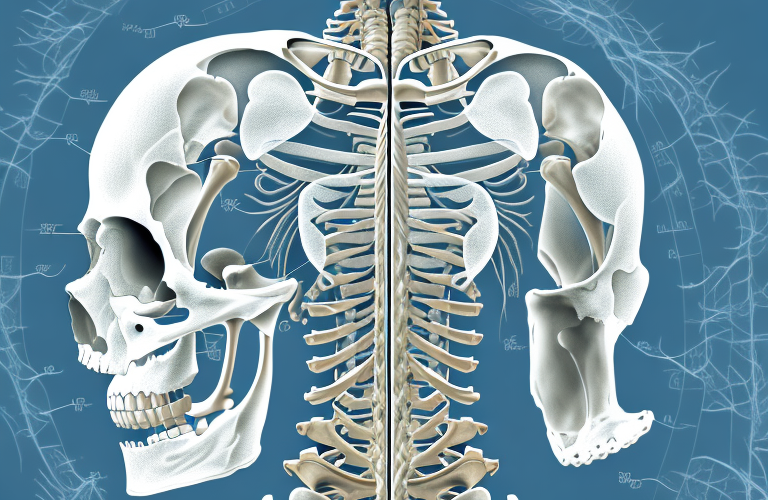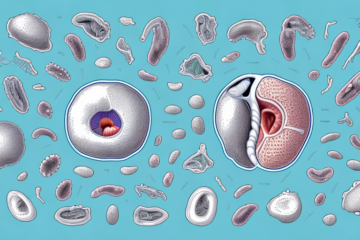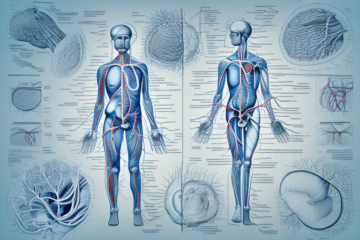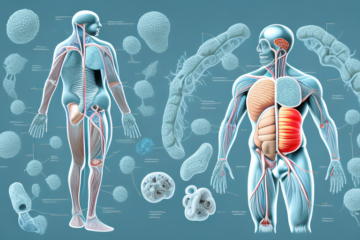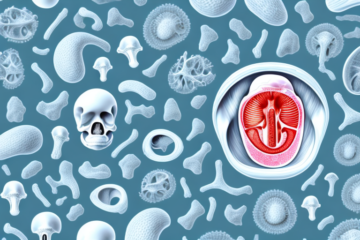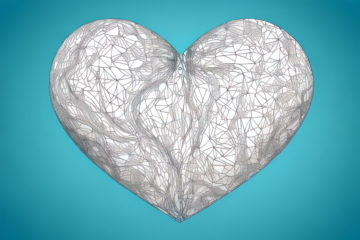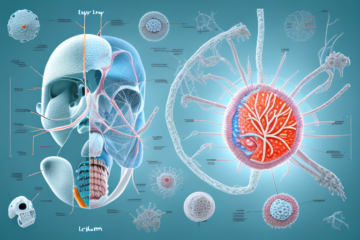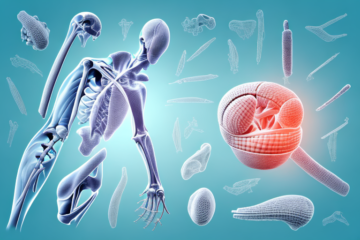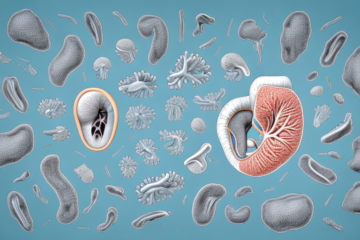Ligaments are a vital component of the human body, responsible for providing stability to joints and connecting bones to each other. They play a crucial role in preventing excessive joint movement and maintaining the structure and position of our bones. In this article, we will explore the anatomy of ligaments, their function, types, and much more.
Understanding the Structure of Ligaments
Ligaments are tough, fibrous cords of connective tissue that attach bones to each other. They are composed of bundles of collagen fibers, arranged in a parallel manner, which allows them to withstand tensile stress. These fibers are surrounded by a matrix of elastic and reticular fibers, which provide flexibility and support.
In addition to their structural composition, ligaments also play a crucial role in joint stability and movement. They act as passive restraints, limiting excessive joint motion and preventing dislocation. However, ligaments can also be prone to injury, especially during high-impact activities or sudden changes in direction.When a ligament is injured, it can result in pain, swelling, and instability in the affected joint. Treatment for ligament injuries typically involves rest, ice, compression, and elevation, as well as physical therapy to help restore strength and range of motion. In severe cases, surgery may be necessary to repair or reconstruct the damaged ligament.Overall, understanding the structure and function of ligaments is important for maintaining joint health and preventing injury. By taking proper precautions and seeking prompt treatment for any injuries, individuals can help ensure the long-term health and stability of their joints.
The Role of Ligaments in Joint Stability
Ligaments are responsible for stabilizing joints and preventing excessive movement. They work in conjunction with muscles and tendons to produce smooth and coordinated movements. When a joint is in motion, ligaments act as a restraint and control the joint’s range of motion.
In addition to their role in joint stability, ligaments also play a crucial role in proprioception, which is the body’s ability to sense its position and movement in space. Ligaments contain specialized nerve endings called proprioceptors, which send signals to the brain about the joint’s position and movement. This information is essential for maintaining balance and coordination during physical activity. Injuries to ligaments can result in decreased proprioception, leading to a higher risk of falls and other accidents. Therefore, it is important to maintain strong and healthy ligaments through proper exercise and injury prevention measures.
Types of Ligaments in the Human Body
The human body has several types of ligaments. Some of the most commonly known types include collateral ligaments, cruciate ligaments, annular ligaments and others. Collateral ligaments hold bones together on the sides of the joint, while the cruciate ligaments provide stability within the joint capsule. The annular ligament is responsible for holding tendons in place around a joint.
In addition to these types of ligaments, there are also extracapsular ligaments and intracapsular ligaments. Extracapsular ligaments are located outside of the joint capsule and provide additional support to the joint. Examples of extracapsular ligaments include the iliotibial band and the fibular collateral ligament. Intracapsular ligaments, on the other hand, are located inside the joint capsule and are responsible for stabilizing the joint. Examples of intracapsular ligaments include the anterior cruciate ligament and the posterior cruciate ligament.Another important aspect of ligaments is their ability to heal after injury. Ligaments have a limited blood supply, which can make healing a slow process. However, with proper treatment and rehabilitation, ligaments can heal and regain their strength. It is important to seek medical attention if you suspect a ligament injury, as untreated injuries can lead to long-term joint instability and other complications.
How Ligaments Work with Muscles and Tendons
Ligaments work with muscles and tendons to provide smooth and coordinated movement. Muscles are responsible for providing the force of movement, while tendons attach the muscles to bones. Ligaments work in conjunction with muscles and tendons to help control the joint’s range of motion and prevent excessive movement.
Additionally, ligaments also play a crucial role in providing stability to joints. They act as strong, fibrous bands that connect bones to each other, helping to keep the joint in place and prevent dislocation. Without ligaments, joints would be much more prone to injury and instability, making movement difficult and painful. Therefore, it is important to maintain the health and strength of ligaments through proper exercise and injury prevention measures.
Factors that Affect Ligament Health and Function
Several factors can affect ligament health and function. These include age, genetics, nutrition, and physical activity level. As we get older, our ligaments become less elastic, making them more prone to injury. Similarly, genetics can play a role in the structure and strength of our ligaments. Proper nutrition and physical activity can help maintain optimal ligament health and function.
In addition to these factors, external forces can also impact ligament health. For example, athletes who participate in high-impact sports are at a greater risk for ligament injuries due to the repetitive stress placed on their joints. Additionally, sudden movements or accidents can cause ligament tears or sprains. It is important to take precautions and properly warm up before physical activity to reduce the risk of injury to ligaments.
Common Injuries Associated with Ligaments
Ligament injuries are quite common, especially among athletes. They can range from mild sprains to complete tears, which can significantly affect joint stability and mobility. Some common ligament injuries include ACL tears, MCL tears, and lateral ligament sprains.
It is important to note that ligament injuries can also occur in everyday activities, such as slipping on a wet floor or twisting an ankle while walking. These injuries can be just as painful and debilitating as those sustained during sports. It is crucial to seek medical attention if you suspect a ligament injury, as proper diagnosis and treatment can prevent further damage and aid in a faster recovery.
Preventive Measures to Protect Your Ligaments
Preventive measures can help protect your ligaments from injury. These include proper nutrition, stretching, wearing appropriate footwear, and using protective equipment. Maintaining a healthy and active lifestyle can also go a long way in preventing ligament injuries.
In addition to these measures, it is important to gradually increase the intensity and duration of physical activity to avoid sudden stress on the ligaments. It is also recommended to warm up before any physical activity and cool down afterwards to prevent injury. If you do experience a ligament injury, it is important to seek medical attention and follow a proper rehabilitation program to prevent further damage and promote healing. By taking these preventive measures, you can reduce your risk of ligament injuries and maintain a healthy and active lifestyle.
Rehabilitation Techniques for Ligament Injuries
Rehabilitation techniques can help speed up the recovery process for ligament injuries. These can include physical therapy, massage, and strengthening exercises. Following a rehabilitation program can help improve strength, flexibility, and joint stability, reducing the risk of re-injury.
In addition to these techniques, some patients may benefit from the use of braces or supports to help stabilize the affected joint during the healing process. These devices can provide additional support and protection, allowing the ligament to heal properly without further damage.It is important to note that rehabilitation techniques may vary depending on the severity and location of the ligament injury. A healthcare professional can provide a personalized rehabilitation plan that takes into account the individual’s specific needs and goals. It is also important to follow the rehabilitation plan closely and attend all scheduled appointments to ensure the best possible outcome.
Surgical Options for Severe Ligament Damage
In some cases, severe ligament damage may require surgical intervention. Surgical options can include ligament repair or reconstruction, using tissue from other parts of the body or synthetic materials. Surgery can help restore joint stability and mobility, but it can also be a lengthy and challenging recovery process.
It is important to note that not all cases of severe ligament damage require surgery. In some cases, non-surgical treatments such as physical therapy, bracing, and rest may be effective in promoting healing and restoring function.However, for those who do require surgery, it is important to carefully consider the risks and benefits. Surgery can carry risks such as infection, bleeding, and nerve damage, and the recovery process can be lengthy and require significant rehabilitation. It is important to discuss all options with a qualified healthcare provider to determine the best course of treatment for each individual case.
Best Ways to Strengthen Your Ligaments
Strengthening exercises can help improve ligament strength and flexibility. Some exercises that can help include resistance training, balance and stability exercises, and stretching. It’s essential to consult with a medical professional before starting any exercise program, especially if you have a history of ligament injuries.
In addition to exercise, maintaining a healthy diet can also contribute to ligament health. Foods rich in vitamin C, such as citrus fruits and leafy greens, can help promote collagen production, which is essential for ligament strength. Additionally, consuming foods high in omega-3 fatty acids, such as salmon and walnuts, can help reduce inflammation and support overall joint health. Incorporating these dietary changes along with exercise can help improve ligament health and prevent future injuries.
Latest Advances in Research and Treatment of Ligament Injuries
Several advances have been made in the research and treatment of ligament injuries. These include stem cell therapy, gene therapy, and the use of growth factors to stimulate ligament healing. Additionally, new surgical techniques and rehabilitation protocols continue to be developed, improving the outcomes of ligament injuries.
One promising area of research is the use of biologics, such as platelet-rich plasma (PRP) and mesenchymal stem cells (MSCs), to promote healing and regeneration of damaged ligaments. PRP is a concentrated solution of platelets and growth factors derived from the patient’s own blood, which can be injected directly into the injured ligament to accelerate healing. MSCs, on the other hand, are multipotent cells that can differentiate into various cell types, including ligament cells, and have shown promising results in preclinical studies.Another area of focus is the development of non-invasive diagnostic tools to accurately assess the severity and extent of ligament injuries. Magnetic resonance imaging (MRI) is currently the gold standard for diagnosing ligament injuries, but it has limitations in terms of sensitivity and specificity. Researchers are exploring alternative imaging modalities, such as ultrasound and optical coherence tomography (OCT), which may provide more detailed and accurate information about ligament injuries without the need for invasive procedures.
Lifestyle Changes to Promote Optimal Ligament Health
Making lifestyle changes can go a long way in promoting optimal ligament health. These can include maintaining a healthy diet, staying physically active, and avoiding bad habits such as smoking and excessive alcohol consumption. Practicing proper posture and body mechanics can also prevent ligament injuries.
In addition to these lifestyle changes, it is important to ensure that you are getting enough rest and sleep. Lack of sleep can weaken your immune system and make you more susceptible to injuries, including ligament injuries. Getting enough rest and sleep can also help your body recover from any injuries or strains that you may have experienced.Another important factor in promoting optimal ligament health is staying hydrated. Drinking enough water can help keep your ligaments and joints lubricated, reducing the risk of injury. It can also help your body flush out toxins and waste products that can contribute to inflammation and pain. Aim to drink at least 8 glasses of water a day, and more if you are physically active or live in a hot climate.
Importance of Proper Nutrition for Stronger Ligaments
Nutrition plays a crucial role in promoting ligament health. Some essential nutrients include protein, vitamin C, and magnesium. Protein is crucial for building and repairing ligament tissue, while vitamin C helps to maintain the structure of collagen fibers. Magnesium can help improve ligament elasticity and prevent injury.
In addition to these nutrients, it is also important to consume foods that are rich in antioxidants. Antioxidants help to reduce inflammation in the body, which can contribute to ligament damage. Foods such as berries, leafy greens, and nuts are all great sources of antioxidants.Furthermore, staying hydrated is also important for maintaining healthy ligaments. Water helps to lubricate the joints and keep the ligaments flexible. It is recommended to drink at least 8 glasses of water per day, and even more if you are physically active or live in a hot climate. By incorporating these dietary habits into your lifestyle, you can help to promote stronger and healthier ligaments.
Tips for Athletes on Maintaining Healthy and Flexible Ligaments
Athletes can take several steps to maintain healthy and flexible ligaments. These include proper warm-up and cool-down exercises, foam rolling, stretching, and rest and recovery. It’s essential to listen to your body and give it the time it needs to recover and heal from any injuries or strains.In conclusion, ligaments play a vital role in joint stability and maintaining the structure and position of our bones. Understanding the anatomy and function of ligaments, as well as taking preventive measures, can help prevent injury and promote optimal ligament health. In cases of severe injury, surgical intervention and rehabilitation can help restore joint stability and mobility. By following proper nutrition and making lifestyle changes, we can help maintain optimal ligament health and prevent injury.
Additionally, athletes should also consider incorporating strength training exercises into their workout routine. Building strength in the muscles surrounding the joints can help support and protect the ligaments. It’s important to work with a qualified trainer or coach to develop a safe and effective strength training program that targets the specific needs of the athlete’s sport and body. By combining strength training with other preventive measures, athletes can reduce their risk of ligament injuries and improve their overall performance.

